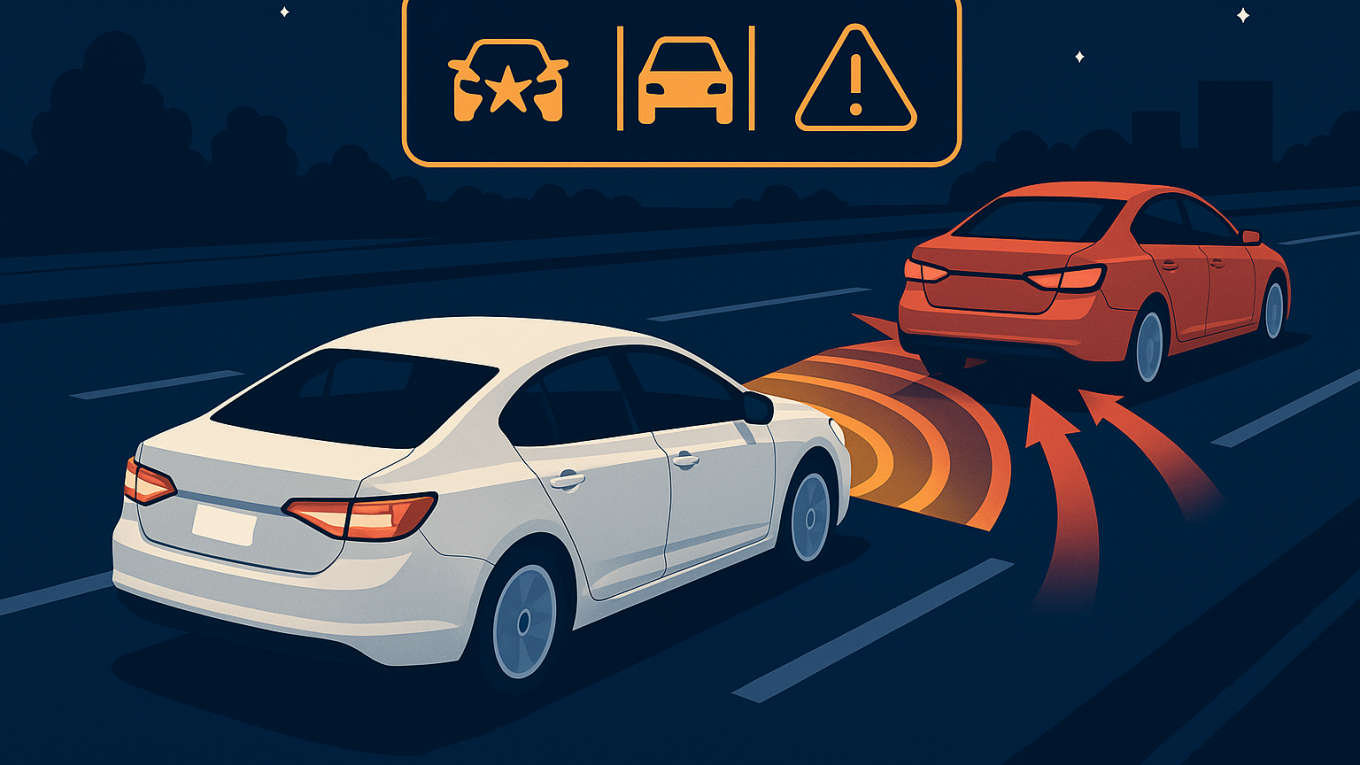Effectiveness of Advanced Driver-Assistance Systems (ADAS)
Advanced Driver-Assistance Systems (ADAS) – a suite of electronic safety features in many newer cars – act like a high-tech co-pilot for drivers. These systems use sensors and smart software to help drivers avoid accidents or lessen their severity. ADAS offers tools ranging from forward-collision warnings to features that can automatically brake or steer in emergencies. However, these aids don’t make a car self-driving – the driver stays in control, with ADAS simply adding a layer of protection against mistakes or surprises on the road.
Many of today’s vehicles now come standard with some ADAS capabilities. They typically employ radar units and cameras to monitor the vehicle’s surroundings and detect potential hazards. If the system senses danger – for example, if you’re closing in on another vehicle too quickly – it can alert you and even act (by braking or swerving) if you fail to respond in time. Real-world studies show that these technologies are already preventing crashes. Vehicles equipped with features like forward collision warning, automatic emergency braking, lane-keeping assistance, and blind spot monitoring have been involved in fewer accidents than those without such aids. The following sections explore how three key ADAS technologies – radar and camera sensors, lane-keeping assistance, and automatic emergency braking – contribute to reducing the risk and severity of collisions.
Table of Contents
ToggleRadar and Camera Technologies in Collision Avoidance
Modern cars often serve as their own lookout, thanks to radar and camera systems working together. Radar sensors use radio waves to detect the position and speed of nearby objects – effectively giving the car a way to “see” how far away other vehicles or obstacles are and how fast they’re moving. Cameras, on the other hand, capture visual details of the road ahead, allowing the vehicle to recognize important elements like lane markings, traffic signs, pedestrians, and other vehicles. By combining data from radar and cameras (an approach called sensor fusion), the car’s onboard computer can form a more accurate picture of the environment and react to potential dangers in real time.
This radar-camera combo forms the backbone of collision avoidance systems. For instance, if radar detects that the gap to the car ahead is closing rapidly and the camera confirms there’s an obstacle in the lane, the system will issue a forward collision warning to grab the driver’s attention. Many cars also pre-charge the brakes in anticipation. If the driver doesn’t respond quickly enough, the system may apply the brakes automatically or even tug the steering to avoid a crash. Collision avoidance systems that use these sensors have proven effective – they’ve been shown to help drivers avoid accidents and reduce the severity of collisions that do occur. In essence, radar and camera technologies act as an ever-vigilant co-driver, spotting trouble that a human might miss and responding in milliseconds to prevent or mitigate an accident.
Lane-Keeping Assistance Systems and Their Role in Crash Prevention
One of the most common causes of serious accidents is a vehicle veering out of its lane – for example, drifting off the road or into oncoming traffic due to driver distraction or drowsiness. Lane-keeping assistance systems are designed to tackle this problem. They typically use a forward-facing camera to monitor the lane markings on the road. If your car starts to drift toward the lane boundaries without a turn signal (indicating it’s unintentional), the system will alert you – often with a buzzer or a vibration in the steering wheel to mimic the feel of rumble strips. More advanced setups don’t just warn you; they also provide gentle steering or braking inputs to nudge the vehicle back into its lane if you don’t react in time. In other words, the car can subtly “fight” the drift, keeping you safely in your lane.
By preventing unintended lane departures, lane-keeping aids significantly reduce the chances of certain types of crashes. Wandering out of lane can lead to side-swipe collisions or devastating head-on crashes, so stopping that drift early is critical. Studies have found that cars with lane departure warning systems are indeed less likely to be involved in single-vehicle run-off-road or head-on crashes than those without the feature. For example, one U.S. study found about an 11% reduction in these lane-departure crashes for cars equipped with a warning system. While that percentage may sound modest, it represents many accidents (and lives) saved, especially since lane-departure crashes are often among the most severe.
These systems are also a boon for tired or distracted drivers. If someone starts to doze off or lose focus, a lane-keeping alert can jolt them back to attention and prevent a potential disaster. And if the driver doesn’t wake up immediately, an active lane-keeping assist that automatically centers the car could be a lifesaver. Earlier lane departure warning systems could be overly sensitive or intrusive, leading some drivers to disable them. Automakers have since refined these alerts – for example, using gentle vibrations instead of loud beeps – to make drivers more comfortable leaving them on.
Automatic Emergency Braking and Its Effectiveness in Real-World Scenarios
Perhaps the most game-changing ADAS feature is Automatic Emergency Braking (AEB). This technology can step in and hit the brakes to prevent a collision if you don’t brake in time yourself. AEB systems continuously scan the road ahead (typically using input from both radar and cameras) to identify vehicles or other obstacles in your path. If a potential collision is detected – say the car in front of you suddenly hits the brakes or a pedestrian steps into the road – the system will first issue an urgent forward collision warning to get your attention. If you don’t react in time, the AEB will automatically apply the brakes at full force. The goal is either to avoid the crash altogether or, if that’s not possible, at least reduce the impact speed to lessen the severity of the collision.
Real-world evidence shows that AEB makes a tremendous difference. According to IIHS, vehicles equipped with forward collision warning plus automatic braking experience about 50% fewer rear-end crashes than the same models without these technologies. Even systems that only warn the driver (without autobraking) still cut rear-end collisions by roughly 27%. Rear-end crashes are among the most common accidents, so cutting them in half is a huge safety gain. Importantly, AEB doesn’t just prevent crashes; it also reduces injury severity in the crashes that do happen. With autobrake, far fewer rear-end collisions result in injuries, because the car often slows itself before impact.
In crash tests, a car going 25 mph without autobraking slammed into a stopped vehicle with devastating results. The same car with AEB engaged hit the obstacle at only about 12 mph, resulting in minor damage. Even a small reduction in speed before impact dramatically lowers crash forces and the risk of serious injury.
AEB is also being extended beyond just car-to-car scenarios. Many newer systems can detect pedestrians and cyclists – and these capabilities have been shown to cut crashes involving people on foot by around 27%. Automakers have rapidly made AEB standard on new vehicles. In fact, 20 major car manufacturers pledged to include forward collision warning and autobrake on nearly all new models by 2022, a goal that has now been largely met.
Steering Toward Safer Roads
Advanced Driver-Assistance Systems are turning cars into safer partners on the road. Radar and camera-based collision avoidance functions act as an extra set of eyes, spotting hazards and reacting faster than a human possibly could. Lane-keeping assistance guards against dangerous drift-out-of-lane errors, helping prevent some of the most serious crashes that can occur when a driver loses focus. And automatic emergency braking serves as a last line of defense, autonomously preventing collisions or softening the blow when an accident is imminent. The data is increasingly confirming what drivers feel firsthand – ADAS features meaningfully reduce crash risk and injury severity in real-world driving. Of course, no technology can eliminate every accident, and drivers must remain attentive. But as these systems become more advanced and widespread, we are moving closer to a future with far fewer collisions and safer roads for everyone.

